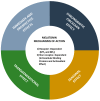Cardioprotective Melatonin: Translating from Proof-of-Concept Studies to Therapeutic Use
- PMID: 31491852
- PMCID: PMC6770816
- DOI: 10.3390/ijms20184342
Cardioprotective Melatonin: Translating from Proof-of-Concept Studies to Therapeutic Use
Abstract
In this review we summarized the actual clinical data for a cardioprotective therapeutic role of melatonin, listed melatonin and its agonists in different stages of development, and evaluated the melatonin cardiovascular target tractability and prediction using machine learning on ChEMBL. To date, most clinical trials investigating a cardioprotective therapeutic role of melatonin are in phase 2a. Selective melatonin receptor agonists Tasimelteon, Ramelteon, and combined melatonergic-serotonin Agomelatine, and other agonists with registered structures in CHEMBL were not yet investigated as cardioprotective or cardiovascular drugs. As drug-able for these therapeutic targets, melatonin receptor agonists have the benefit over melatonin of well-characterized pharmacologic profiles and extensive safety data. Recent reports of the X-ray crystal structures of MT1 and MT2 receptors shall lead to the development of highly selective melatonin receptor agonists. Predictive models using machine learning could help to identify cardiovascular targets for melatonin. Selecting ChEMBL scores > 4.5 in cardiovascular assays, and melatonin scores > 4, we obtained 284 records from 162 cardiovascular assays carried out with 80 molecules with predicted or measured melatonin activity. Melatonin activities (agonistic or antagonistic) found in these experimental cardiovascular assays and models include arrhythmias, coronary and large vessel contractility, and hypertension. Preclinical proof-of-concept and early clinical studies (phase 2a) suggest a cardioprotective benefit from melatonin in various heart diseases. However, larger phase 3 randomized interventional studies are necessary to establish melatonin and its agonists' actions as cardioprotective therapeutic agents.
Keywords: cardioprotection; cardiovascular system; drugs; in silico; machine learning; melatonin.
Conflict of interest statement
The authors declare no conflict of interest.
Figures






Similar articles
-
Multiplatform-Integrated Identification of Melatonin Targets for a Triad of Psychosocial-Sleep/Circadian-Cardiometabolic Disorders.Int J Mol Sci. 2023 Jan 3;24(1):860. doi: 10.3390/ijms24010860. Int J Mol Sci. 2023. PMID: 36614302 Free PMC article.
-
MT1 and MT2 melatonin receptors: ligands, models, oligomers, and therapeutic potential.J Med Chem. 2014 Apr 24;57(8):3161-85. doi: 10.1021/jm401343c. Epub 2013 Nov 14. J Med Chem. 2014. PMID: 24228714
-
Melatonin in cardiovascular disease.Expert Opin Investig Drugs. 2012 Nov;21(11):1593-6. doi: 10.1517/13543784.2012.716037. Epub 2012 Aug 23. Expert Opin Investig Drugs. 2012. PMID: 22916801
-
Beneficial effects of melatonin in cardiovascular disease.Ann Med. 2010 May 6;42(4):276-85. doi: 10.3109/07853890903485748. Ann Med. 2010. PMID: 20455793 Review.
-
Cardiovascular effects of melatonin receptor agonists.Expert Opin Investig Drugs. 2012 Nov;21(11):1661-78. doi: 10.1517/13543784.2012.714771. Epub 2012 Aug 23. Expert Opin Investig Drugs. 2012. PMID: 22916799 Review.
Cited by
-
Getting an Early Start in Understanding Perinatal Asphyxia Impact on the Cardiovascular System.Front Pediatr. 2020 Feb 26;8:68. doi: 10.3389/fped.2020.00068. eCollection 2020. Front Pediatr. 2020. PMID: 32175294 Free PMC article. Review.
-
Melatonin against pulmonary arterial hypertension: is it ready for testing in patients?Cardiovasc J Afr. 2021 Mar-Apr;32(2):111-112. doi: 10.5830/CVJA-2021-008. Cardiovasc J Afr. 2021. PMID: 34143177 Free PMC article.
-
Melatonin as a Reducer of Neuro- and Vasculotoxic Oxidative Stress Induced by Homocysteine.Antioxidants (Basel). 2021 Jul 24;10(8):1178. doi: 10.3390/antiox10081178. Antioxidants (Basel). 2021. PMID: 34439426 Free PMC article. Review.
-
Effects of berbamine against myocardial ischemia/reperfusion injury: Activation of the 5' adenosine monophosphate-activated protein kinase/nuclear factor erythroid 2-related factor pathway and changes in the mitochondrial state.Biofactors. 2022 May;48(3):651-664. doi: 10.1002/biof.1820. Epub 2022 Feb 7. Biofactors. 2022. PMID: 35129229 Free PMC article.
-
Effect of melatonin on heart failure: design for a double-blinded randomized clinical trial.ESC Heart Fail. 2020 Oct;7(5):3142-3150. doi: 10.1002/ehf2.12829. Epub 2020 Jul 2. ESC Heart Fail. 2020. PMID: 32618134 Free PMC article. Clinical Trial.
References
-
- Bouatia-Naji N., Bonnefond A., Cavalcanti-Proença C., Sparsø T., Holmkvist J., Marchand M., Delplanque J., Lobbens S., Rocheleau G., Durand E., et al. A variant near MTNR1B is associated with increased fasting plasma glucose levels and type 2 diabetes risk. Nat. Genet. 2009;41:89–94. doi: 10.1038/ng.277. - DOI - PubMed
Publication types
MeSH terms
Substances
Grants and funding
LinkOut - more resources
Full Text Sources
Research Materials

